Score
| |
1 |
2 |
3 |
4 |
5 |
6 |
total |
| Garry Kasparov |
1 |
½ |
0 |
½ |
|
|
2 |
| Deep Junior |
0 |
½ |
1 |
½ |
|
|
2 |
Junior Shows What It Knows in Game Four
Two-thirds through the "First Official Man-Machine
World Chess Championship" (FOMMWOCC?) the match between Garry Kasparov
and Deep Junior is tied at 2-2 with a win apiece and two draws. Kasparov
held off Junior with the black pieces today, although not in the effortless
way he might have hoped. After a brutally abrupt loss in game three Kasparov
no doubt wished for an easy draw before his white in game five on Wednesday.
Garry Kasparov brought Deep Junior into a closed, maneuvering
position in game four. The ..e6 Sicilian from game two turned into
Hedgehog, one of the few systems in the chess encyclopedia that is fully comprehensible
from its name. (The Giuoco Piano is rarely quiet, the Queen's Gambit often isn't
one, and the Anti-Meran has nothing to do with King Philip II in 1196.)
In typical Hedgehog fashion Kasparov put all his pieces
and pawns on the first three ranks. He also tossed in an odd knight
hop on move eight in order to get Junior out of its opening library and thinking
on its own. From the thousands of games that had reached the position after
8.Na3, no one had ever played 8...Nd7, which is remarkable. In
the post-game press conference Kasparov joked that it was a "brilliant
move" before continuing, "Okay it's a lousy move but it got the computer
out of book." In hindsight that might not have been such a great idea.
In the maneuvering session that followed, Junior only
occasionally exhibited the lack of comprehension of the position that you might
expect. The board was full of pawns and the position required artifice
and planning, not brute force and tactical wizardry. In the olden days this
would have been dark clouds on the horizon for the computer player.
With open lines and free piece play a program's powers
of calculation are in full effect. But with a dozen or more pawns
on the board and no clear targets machines tend to drift, either making useless
waiting moves or embarking on Quixotic adventures that can easily backfire.
Junior did a little of both of these things from moves
nine to 22, but most of the time it played competent, intelligent chess. Kasparov
wasn't exactly burning with ambition either, although that's exactly how you
have to handle the Hedgehog on both sides. Black curls up and lies in ambush
in case White overpresses or lets down his guard. White proceeds with caution,
snipping off the points of the quills one by one until Black is left defenseless
against a breakthrough or is crushed under the pressure.
A few of Deep Junior's moves drew laughter from the
Grandmasters because they were clear signs that the program had no idea how
to continue. In particular, 12.h3 and 18.a3 were the
sort of moves a beginner makes because they don't mess anything up. They also
make chess programmers wince visibly. Computers can't plan, of course. They
must see every move in sequence, beginning from the position on the board. They
cannot visualize strategic goals or fantasize about how to achieve them.
A human can look at a position and think,
"Wouldn't it be nice if I could get my knight to the b4 square? It would
be very strong there, how can I make that happen?" A computer thinks, "I
go there he goes there I go there he goes there I go there he goes there I go
there and my evaluation goes up to +0.21." If that analysis reaches as
far as achieving the human's visualization, the same end can occur by very different
means.
Top programs like Junior can perform that analysis
so fast and evaluate the results so well that they can simulate human planning.
This is really put to the test in closed positions in which human
visualization is superior to computer calculation. In game four Junior showed
us that this gap is getting smaller all the time.
While Junior did drift considerably, Kasparov was not interested in challenging
the machine by attempting to wrest the initiative with black. He preferred to
wait and see what the Israeli program would come up with against his solid but
spiky defensive wall. Unfortunately for Kasparov, Junior came up with enough
to gain a serious, perhaps decisive advantage.
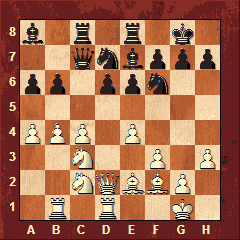 The crisis finally came with
(diagram) 24.a5!? bxa5 25.b5. This maneuver is illustrative of
Junior's uncomputerlike disdain for material. It gave up a pawn in order to
plant another on the advanced b6 square where it inhibited Black's pieces and
created various tactical possibilities. And since I have been unable to duplicate
24.a5 with any of the various top programs (including Deep Junior 7) it also
shows what a special beast this Junior is. World #3 Vishy Anand was following
along at Playchess.com and he immediately said that he had been wondering if
this ambitious push was possible. But no one would expect this from a computer,
at least not one that plays like a computer!
The crisis finally came with
(diagram) 24.a5!? bxa5 25.b5. This maneuver is illustrative of
Junior's uncomputerlike disdain for material. It gave up a pawn in order to
plant another on the advanced b6 square where it inhibited Black's pieces and
created various tactical possibilities. And since I have been unable to duplicate
24.a5 with any of the various top programs (including Deep Junior 7) it also
shows what a special beast this Junior is. World #3 Vishy Anand was following
along at Playchess.com and he immediately said that he had been wondering if
this ambitious push was possible. But no one would expect this from a computer,
at least not one that plays like a computer!
When a program evaluates a position almost all of the
weight comes from material balance. "Who has more stuff?"
the computer asks after calculating each move. This sounds a little brain-dead,
but it asks this question a few million times per second! Along with that fundamental
calculation, programs add in pieces of knowledge, the sort of thing humans use:
space, king safety, passed pawns, etc.
So when a program plays a move that involves giving
up material for positional considerations it is betraying its very nature. Junior
does this so regularly, and so well, that game after game you can see that co-programmer
Shay Bushinsky said quite a lot when he said in a press conference this week
that the difference between Junior and other top programs was that Junior gave
less importance to material.
Before we go too far we should point out that just
because a move isn't computer-like doesn't mean it's the best move!
But Junior is consistently good at justifying these curious decisions. Its 24.a5
in game four was just such a move. The commentators soon turned against Junior's
aggressive decision, saying that the passed b-pawn would eventually be surrounded
and chopped down, leaving Black with the advantage. 35 moves later when the
draw was agreed the pawn still stood on b6 like a statue in the Louvre that
had seen the French Revolution take place around it. If Junior wasn't completely
right, it wasn't wrong either.
Not that Junior played flawlessly. It was
hasty in entering an endgame that looked good but that most GMs would quickly
decree a theoretical draw. Kasparov admitted after the game that had Junior
kept the light-squared bishops his position was probably lost. Instead, Junior
traded the bishops and took 20 moves to realize that its extra pawn was worthless.
(Actually it never realized this at all, but operator Shay Bushinsky acknowledged
that White was not making any progress and offered the draw.) Kasparov showed
he could also sacrifice pawns by forcing the queens off the board with 47...R5c7
instead of the prosaic 47...Rb8, which might have let Junior keep all the heavy
pieces on the board.
It was a strange and complex game. Commentators
Ashley and Seirawan took turns admitting they had no idea what was going on
and no idea what the players were doing. Several guest star analysts like Joel
Benjamin, Jennifer and Greg Shahade, and Susan Polgar were also brought up to
the stage to confess that they had no idea either. They often wondered if the
players had any idea themselves! Several redundant-looking knight maneuvers
were later declared essential while others stayed redundant. Kasparov was happy
that he had managed not to blunder in a tricky position with under 10 minutes
on his clock before move 40.
Junior showed that it could make something from nothing
instead of foundering when there were no targets to aim at. It made
a few pointless pawn moves only to follow them up with useful ones. Most importantly,
it showed that Kasparov couldn't just set up a defensive wall and take a nap.
Junior pressed him for almost six hours, although the last 30 minutes were purely
academic.
Four games have passed and all four have been rich
in chess, a tremendous ratio. As Kasparov said after the game, flashing
his poetic side, "I wanted to play normal chess, not anti-computer chess.
It's like normal chess with a few small modifications. It's a game with the
same ball and the same net, but you have to compensate for the wind!"
He will have the white pieces for the final time on
Wednesday the 5th. He has had Junior under intense pressure in just
a dozen moves in both games with white so far, so he has every reason to be
optimistic. But Amir Ban pointed out that they have their only win with black,
so they also have grounds for optimism.
Replay the game here
Picture gallery from game 4
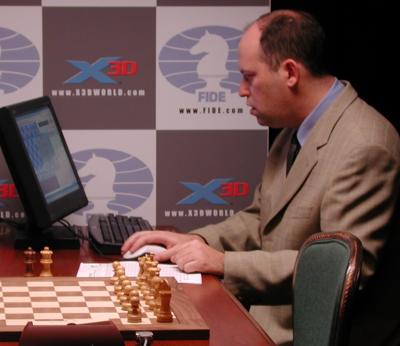
Junior author Shay Bushinsky preparing the machine for game four
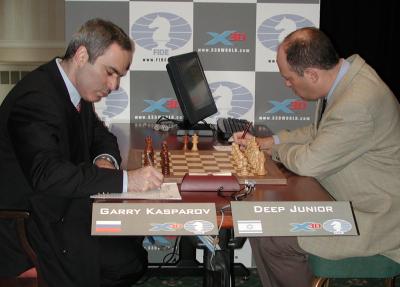
The technicalities: writing down names and dates on the scoresheets
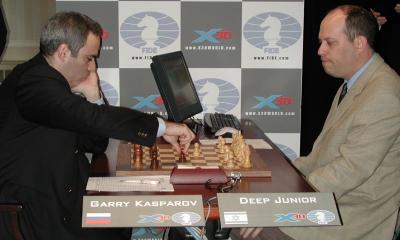
...and then the first moves: Sicilian Defence
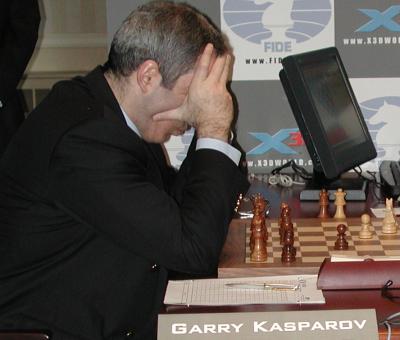
Full concentration (and out with the photo journalists)

The theatre packed, with people standing in the back

... and sitting on the floor in front of the first row
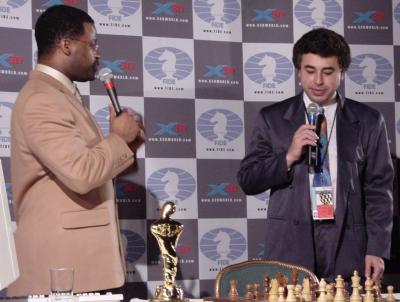
GMs Maurice Ashley and Yasser Seirawan doing the commentary
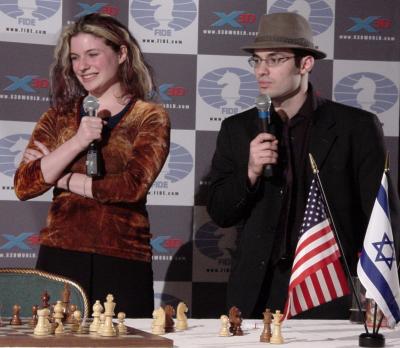
with Jennifer and Greg Shahade helping out

The "Internet corner", were the world-wide broadcast is done, with
Mig Greengard, GM Joel Benjamin, John Fernandez, GM Max Dlugy

Hogging the Playchess server: sitting in the middle Max Dlugy, standing in the
grey suit Michael Khodakovsky, one of Kasparov's seconds.

GM Boris Alterman, one of the three-man Junior team

Always a pleasure when she drops by: Anna Hahn

The US women's champion helping Mig with the live commentary

Meanwhile Garry Kasparov on the giant 3D screen is under pressure, before forcing
the draw.



















 The crisis finally came with
(diagram) 24.a5!? bxa5 25.b5. This maneuver is illustrative of
Junior's uncomputerlike disdain for material. It gave up a pawn in order to
plant another on the advanced b6 square where it inhibited Black's pieces and
created various tactical possibilities. And since I have been unable to duplicate
24.a5 with any of the various top programs (including Deep Junior 7) it also
shows what a special beast this Junior is. World #3 Vishy Anand was following
along at Playchess.com and he immediately said that he had been wondering if
this ambitious push was possible. But no one would expect this from a computer,
at least not one that plays like a computer!
The crisis finally came with
(diagram) 24.a5!? bxa5 25.b5. This maneuver is illustrative of
Junior's uncomputerlike disdain for material. It gave up a pawn in order to
plant another on the advanced b6 square where it inhibited Black's pieces and
created various tactical possibilities. And since I have been unable to duplicate
24.a5 with any of the various top programs (including Deep Junior 7) it also
shows what a special beast this Junior is. World #3 Vishy Anand was following
along at Playchess.com and he immediately said that he had been wondering if
this ambitious push was possible. But no one would expect this from a computer,
at least not one that plays like a computer!


















